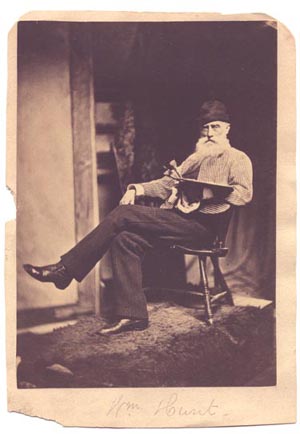William Morris Hunt (William Morris Hunt)

Artist. William was the son of a Vermont congressman. He learned to draw at an early age, his first teacher being an Italian artist named Gambadella. After leaving Harvard College in his third year. Following the untimely death of his father from cholera, William was taken in 1844 by his widowed mother Jane Leavitt Hunt and her other four children to the south of France. After travel in the Middle East, they stopped in Rome where William did some drawing in the studio of American sculptor, Henry Kirke Brown. In 1845, he entered the Düsseldorf Academy, but left the next year for Paris where he became a pupil of Thomas Couture from 1846 to 1852. The sight of Millet’s The Sower at the Salon of 1851 in Paris inspired William to spend most of the next two years with Millet at Barbizon. He returned to the United States in 1854 and two years later moved to Newport, Rhode Island, where he painted and took a few pupils. The companionship of Millet had a lasting influence on Hunt’s character and style, and his work grew in strength, in beauty and in seriousness. He was among the biggest proponents of the Barbizon school in America, and he more than any other turned the rising generation of American painters towards Paris. On his return in 1855 he painted some of his most handsome canvases, all reminiscent of his life in France and of Millet’s influence. Such are The Belated Kid, Girl at the Fountain, Hurdy-Gurdy Boy, and others, but the public called for portraits, and it became the fashion to sit for Hunt; among his best paintings of this genre are those of William M. Evarts, Mrs Charles Francis Adams, the Rev. James Freeman Clarke, Senator Charles Sumner, William H. Gardner, Chief Justice Shaw and Judge Horace Gray. In 1862, he settled permanently in Boston where the demand for his portraits grew as did the size and popularity of his classes. His last trip to Europe was made in 1867. The great Boston fire of 1872 destroyed many of William’s paintings and sketches, together with five large Millets and other art treasures collected by him in Europe. He owned many canvases by Millet, including Millet’s The Sower. William separated from his wife, socialite Louisa Perkins in 1874. Among his later works American landscapes predominated. In the summer of 1878, William painted a series of sweeping views of Niagara Falls. His later works also include the “Bathers: Twice Painted” and “The Allegories” for the Assembly Chamber of the State Capitol at Albany, New York, now lost due to disintegration of the stone panels on which they were painted. There have been some scholars trace William’s deepening depression that led to his suicide to his despair over the loss of the Albany murals. His book, Talks about Art London, 1878, was especially well received. William had gone to the New Hampshire shore to recover from a crippling depression. But he continued to work, executing his last sketch three days before his death. His body was discovered by his friend New Hampshire poet Celia Thaxter. William Morris Hunt died at the Isles of Shoals, New Hampshire, in 1879. He has been called the most influential artist of his time. (bio by: Shock) Family links: Parents: Jonathan Hunt (1787 – 1832) Jane Maria Leavitt Hunt (1801 – 1877) Spouse: Louisa Dumeresq Perkins Hunt (1831 – 1897)* Children: Mabel De Carteret Hunt Slater (1865 – 1942)* Siblings: Jane Hunt (1822 – 1907)* William Morris Hunt (1824 – 1879) Richard Morris Hunt (1827 – 1895)* Leavitt Hunt (1831 – 1907)* *Calculated relationshipCause of death: Drowned
Born
- March, 31, 1824
- USA
Died
- September, 09, 1879
- USA
Cause of Death
- Drowned
Cemetery
- Prospect Hill Cemetery
- Vermont
- USA

